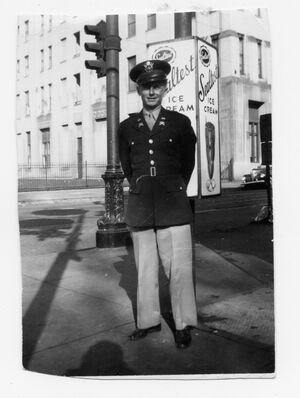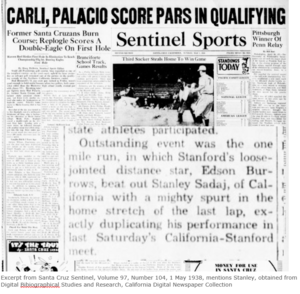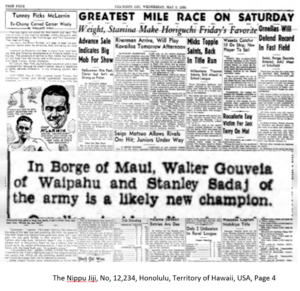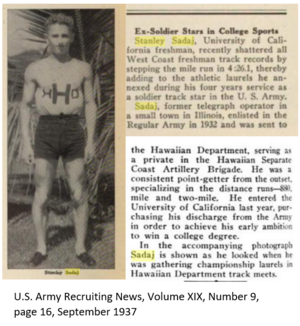Biography
Stanley was born in 1913. He passed away in 1945.
An accomplished athlete, the Christopher, Illinois native, Stan enlisted in the U.S. Army in 1932. He served in the Hawaii Department as a private in the Hawaii Separate Coast Artillery Brigade. [1] He was released early to leave the Army and begin a college education at University of California, Berkeley. When World War II started, he went back in the Army, this time as an officer, to serve America when it called.
2nd Lt. Sadaj graduated from the Fort Sill Artillery School Officer Candidate School in Class 44-42.Oklahoma. He was temporarily assigned for the Basic Flying Training Course, Harte Flying Service, Denton Texas for 10 weeks, beginning in January 1943.
He was trained as an Aerial observer, and served in this capacity in the European Theater of Operations (ETO). Entry date into the ETO is not known. From 1944 until his death, he was an aerial observer in the 400th Armored Field Artillery.
He was killed in action during an artillery observation mission near Remagen, Germany when his small aircraft was shot down. The aircraft most likely was a Stinson L-5 "Sentinel", a light observation aircraft. [2] [3]
"As long as one remembers, they will not be forgotten."
He was interred in Saint Andrews Cemetery, Christopher, Franklin County, Illinois. [4]
Stanley’s military decorations include: Army Distinguished Service Cross, Purple Heart Medal, American Campaign Medal, Europe/African/Middle Eastern Campaign Medal (with Bronze Star), World War II Victory Medal, US Presidential Unit Citation [5] [6]
Distinguished Service Cross (Posthumously awarded)
The President of the United States of America, authorized by Act of Congress, July 9, 1918, takes pride in presenting the Distinguished Service Cross (Posthumously) to Second Lieutenant Stanley S. Sadaj , United States Army, for extraordinary heroism in connection with military operations against an armed enemy while serving with Company C, 400th Armored Field Battalion, in action against enemy forces in Germany, on 7 March 1945.
On that date, Lieutenant Sadaj and a pilot were on an observation mission, flying low over the point units of the spearhead striking towards Remagen, Germany. Without thought of their own safety they braved enemy anti-aircraft fire to observe and direct fire upon enemy installations as the striking troops approached and formed for the assault against the bridge across the Rhine River. When enemy fire hit the plane, causing it to crash, they were flying too low to parachute to safety, and Lieutenant Sadaj and the pilot were killed.
The courage and determination Second Lieutenant Sadaj displayed and his supreme devotion to duty at the cost of his life, exemplify the highest traditions of the military forces of the United States and reflect great credit upon himself, his unit, and the United States Army.
Letter to Widow from Commanding Officer[8] April 1, 1945
Mrs. Evelyn W. Sadaj 608 Chestnut Street Louisville, Kentucky
There is little, I realize, that anyone can say to help lessen the grief that you and many others throughout America are experiencing over the loss of your husband and theirs in this war. I would like, however, to tell you something of the circumstances surrounding the death of 2d Lt. STANLEY S. SADAJ, 0-1175300, and how his Battalion and the men who knew him felt about his death.
On 7 March 1945, during the course of the establishment of a bridgehead across the Rhine River, Stan was acting as observer from the liaison plan for the force of which this battalion was a part. He was flying in the face of heavy small arms and antiaircraft fire. It was during this battle that the plane was hit. I saw him crash and ran to the plane. When I arrived Stan was dead. I am sure that he suffered no pain and that death was instantaneous. His body was evacuated promptly and buried in an American Cemetary somewhere in Belgium. Burial services were conducted by a Chaplain in his faith.
There was not a man in the battalion who did not feel deeply grieved at the news, because he had something that not all men have - it is a spirit, a character that I like to think of as [next two words unreadable] in his its best and finest sense; good nature, cheerfulness, a willingness to do more than his share, an ability to lead, not because he was bigger or tougher than the next fellow but because the next fellow was willing to follow him, together with a courage that enabled him to come up from the roughest going with a grin and a quip. Your husband was a real man.
Stan was killed by the enemy, but what the enemy is beginning to realize is that America has bred enough men with character and courage like his to make the destruction of the enemy and what he stands for, inevitable.
We are proud to have had him with us, and are deeply sorry that he is gone.
Sincerely yours, John R. McLean Lt Col., 400th A. FA., Commanding
Sources
- ↑ U.S. Army Recruiting News, Volume XIX, Number 9, page 16, September 1937
- ↑ Records provided via Freedom of Information Act request to National Personnel Records Center (NPRC) in St. Louis
- ↑ United States Army in World War II, The European Theater of Operations: The Last Offensive, Volume 3, by Charles B. MacDonald, Office of the Chief of Military History, United States Army, Washington, D.C., 1973, Library of Congress Card Catalogue Number, 71-183070, page 487
- ↑ Find a Grave - [1]
- ↑ Records provided via Freedom of Information Act request to National Personnel Records Center (NPRC) in St. Louis
- ↑ United States Army in World War II, The European Theater of Operations: The Last Offensive, Volume 3, by Charles B. MacDonald, Office of the Chief of Military History, United States Army, Washington, D.C., 1973, Library of Congress Card Catalogue Number, 71-183070, page 487
- ↑ General Orders: Headquarters, Third U.S. Army, General Orders No. 120 (May 29, 1945)
- ↑
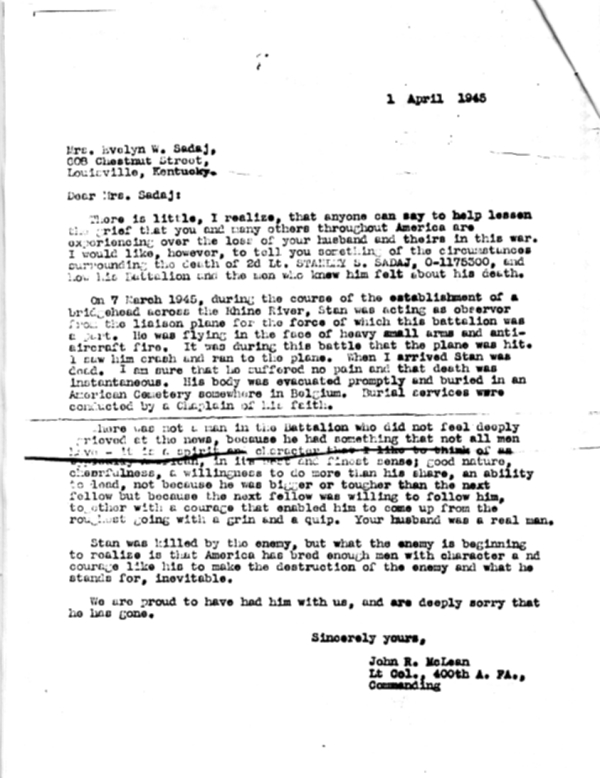
- ↑ Photocopy of letter obtained by Kevin Sadaj from niece of Stanley’s widow, August 2010 via postal mail.
Records provided via Freedom of Information Act request to National Personnel Records Center (NPRC) in St. Louis
Find a Grave - https://www.findagrave.com/memorial/111979117/stanley-scholasticus-sadaj
No known carriers of Stanley's ancestors' DNA have taken a DNA test.
Have you taken a DNA test? If so, login to add it. If not, see our friends at Ancestry DNA.
S > Sadaj > Stanley Scholasticus Sadaj
Categories: Killed in Action, United States of America, World War II | Distinguished Service Cross (United States) | Purple Heart | Roll of Honor Military Showcase Profile

